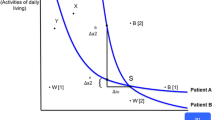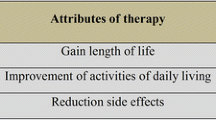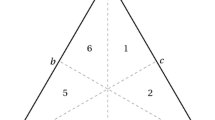Abstract
There is increasing interest in using ranking tasks, discrete choice experiments and best-worst scaling studies to estimate QALY values for use in cost-utility analysis. The research frontier in choice modelling is moving rapidly, with a number of issues being explored across several disciplines. These issues include the estimation of discount factors, proper modelling of the variance scale factor and the estimation of individual-level utility functions. Some of these issues are particularly acute when discrete choice tasks are used to facilitate extra-welfarist analyses that rely on populationbased values. There are also potential problems in implementing such tasks that have received little interest in the non-health discrete choice literature because they are specific to the QALY framework. This article details these issues and offers recommendations on the conduct of 21st century QALY valuation exercises that propose to use any tasks that rely on discrete choices.

Similar content being viewed by others
References
Arnesen T, Trommald M. Are QALYs based on time trade-off comparable? A systematic review of TTO methodologies. Health Econ 2005; 14: 39–53
Richardson J. Cost utility analysis: what should be measured? Soc Sci Med 1994; 39 (1): 7–21
Luce RD. Individual choice behavior. New York: John Wiley & Sons, 1959
Williams A. The measurement and valuation of health: a chronicle [report no. 136]. York: University of York, 1995
Ryan M, Netten A, Skatun D, et al. Using discrete choice experiments to estimate a preference-based measure of outcome: an application to social care for older people. J Health Econ 2006; 25 (5): 927–44
Coast J, Flynn TN, Natarajan L, et al. Valuing the ICECAP capability index for older people. Soc Sci Med 2008; 67: 874–82
Ben-Akiva M, Lerman SR. Discrete choice analysis: theory and application to travel demand. Cambridge (MA): MIT Press, 1985
Thurstone LL. A law of comparative judgment. Psychol Rev 1927; 34: 273–86
McFadden D, Zarembka P. Conditional logit analysis of qualitative choice behavior: frontiers in econometrics. New York: Academic Press, 1974: 105–42
Hensher DA, Louviere JJ, Swait J. Combining sources of preference data. J Econom 1999; 89: 197–221
Louviere JJ. What you don’t know might hurt you: some unresolved issues in the design and analysis of discrete choice experiments. Environ Res Econ 2006; 34: 173–88
Flynn TN, Louviere JJ, Peters TJ, et al. Using discrete choice experiments to understand preferences for quality of life. Variance scale heterogeneity matters. Soc Sci Med. In press
McFadden D, Train K. Mixed MNL models for discrete response. J Appl Econom 2000; 15 (15): 447–70
Fiebig DG, Keane MP, Louviere J, et al. The generalized multinomial logit model: accounting for scale and coefficient heterogeneity. Marketing Sci. Epub 2009 Jul 23 [online]. Available from URL: http://mktsci.journal.informs.org/cgi/content/abstract/mksc.1090.0508v1 [Accessed 2010 Apr 21]
Luce RD, Suppes P, Bush RR, et al. Preference utility and subjective probability: handbook of mathematical psychology. Vol III. New York: Wiley, 1965: 249–410
Marley AAJ. Some probabilistic models of simple choice and ranking. J Math Psychol 1968; 5: 333–55
Beggs S, Cardell S, Hausman J. Assessing the potential demand for electric cars. J Econom 1981; 16: 1–19
Salomon JA. Reconsidering the use of rankings in the valuation of health states: a model for estimating cardinal values from ordinal data. Popul Health Metr 2003; 1 (1): 12
McCabe C, Brazier JE, Gilks P, et al. Using rank data to estimate health state utility models. JHealth Econ 2006; 25: 418–31
Flynn TN, Louviere JJ, Marley AAJ, et al. Rescaling quality of life values from discrete choice experiments for use as QALYs: a cautionary tale. Popul Health Metr 2008; 6: 1–6
Hausman JA, Ruud PA. Specifying and testing economic models for rank-ordered data. J Econom 1987; 34: 83–104
Ben-Akiva M, Morikawa T, Shiroishi F. Analysis of the reliability of preference ranking data. J Bus Res 1991; 23: 253–68
Finn A, Louviere JJ. Determining the appropriate response to evidence of public concern: the case of food safety. J Pub Pol Mark 1992; 11 (1): 12–25
Louviere JJ, Street DJ, Burgess L, et al. Modelling the choices of single individuals by combining efficient choice experiment designs with extra preference information. J Choice Modell 2008; 1 (1): 128–63
Helson H. Adaptation-level theory. New York: Harper & Row, 1964
Louviere JJ, Hensher DA, Swait J. Stated choice methods: analysis and application. Cambridge: Cambridge University Press, 2000
Lancsar E, Louviere JJ. Conducting discrete choice experiments to inform healthcare decision making: a user’s guide. Pharmacoeconomics 2008; 26 (8): 661–77
Bleichrodt H. A new explanation for the differences between time trade-off utilities and standard gamble utilities. Health Econ 2002; 11: 447–56
Street DJ, Burgess L. The construction of optimal stated choice experiments: theory and methods. New York: John Wiley & Sons Inc., 2007
Marley AAJ, Louviere JJ. Some probabilistic models of best, worst, and best-worst choices. J Math Psychol 2005; 49: 464–80
Marley AAJ, Flynn TN, Louviere JJ. Probabilistic models of set-dependent and attribute-level best-worst choice. J Math Psychol 2008; 52: 281–96
Szeinbach SL, Barnes JH, McGhan WF, et al. Using conjoint analysis to evaluate health state preferences. Drug Inf J 1999; 33: 849–58
Flynn TN, Louviere JJ, Peters TJ, et al. Best-worst scaling: what it can do for health care research and how to do it. J Health Econ 2007; 26 (1): 171–89
Carson RT, Groves T. Incentive and informational properties of preference questions. Environ Res Econ 2007; 37: 181–200
Swait J, Louviere JJ. The role of the scale parameter in the estimation and comparison of multinomial logit models. J Market Res 1993; 30: 305–14
Dolan P. Developing methods that really do value the ‘Q’ in the QALY. Health Econ Pol Law 2008; 3: 69–77
Dolan P, Kahneman D. Interpretations of utility and their implications for the valuation of health. Econ J 2008; 118: 215–34
Sen A. Human rights and capabilities. J Hum Devel 2005; 6: 151–66
Attema AE, Brouwer WBF. The correction of TTO-scores for utility curvature using a risk-free utility elicitation method. J Health Econ 2009; 28: 234–43
Salisbury LC, Feinberg FM. Alleviating the constant stochastic variance assumption in marketing research: theory, measurement and experimental test. Market Sci 2010; 29 (1): 1–17
Yatchew A, Griliches Z. Specification error in probit models. Rev Econ Stat 1985; 67 (1): 134–9
Mood C. Logistic regression: why we cannot do what we think we can do, and what we can do about it. Euro Sociol Rev 2010; 26 (1): 67–82 [online]. Available from URL: http://esr.oxfordjournals.org/cgi/content/short/26/1/67 [Accessed 2010 Apr 21]
Acknowledgements
No sources of funding were used to assist in the preparation of this article. The author has no conflicts of interest that are directly relevant to the content of this article.
Author information
Authors and Affiliations
Corresponding author
Rights and permissions
About this article
Cite this article
Flynn, T.N. Using Conjoint Analysis and Choice Experiments to Estimate QALY Values. Pharmacoeconomics 28, 711–722 (2010). https://doi.org/10.2165/11535660-000000000-00000
Published:
Issue Date:
DOI: https://doi.org/10.2165/11535660-000000000-00000




